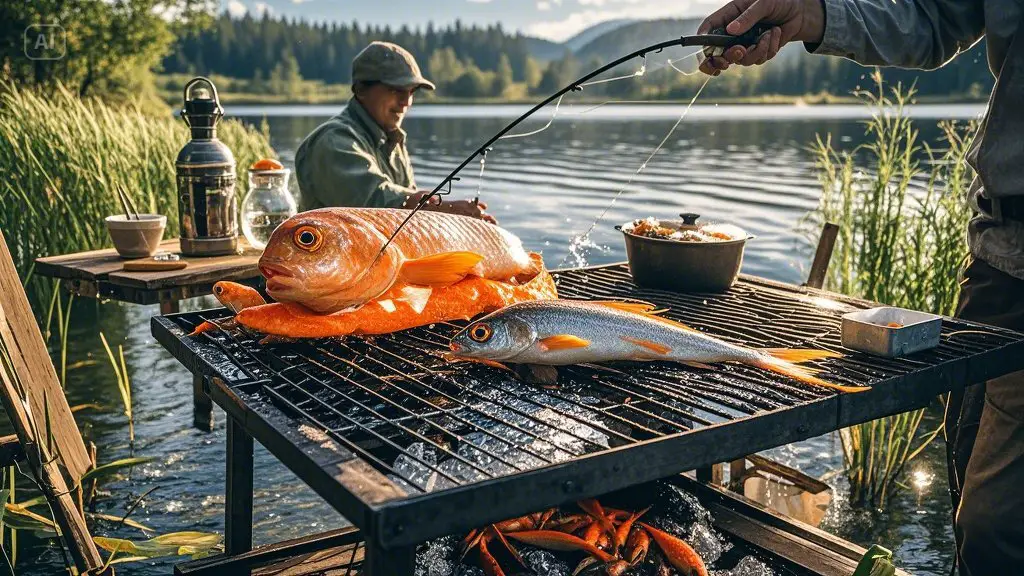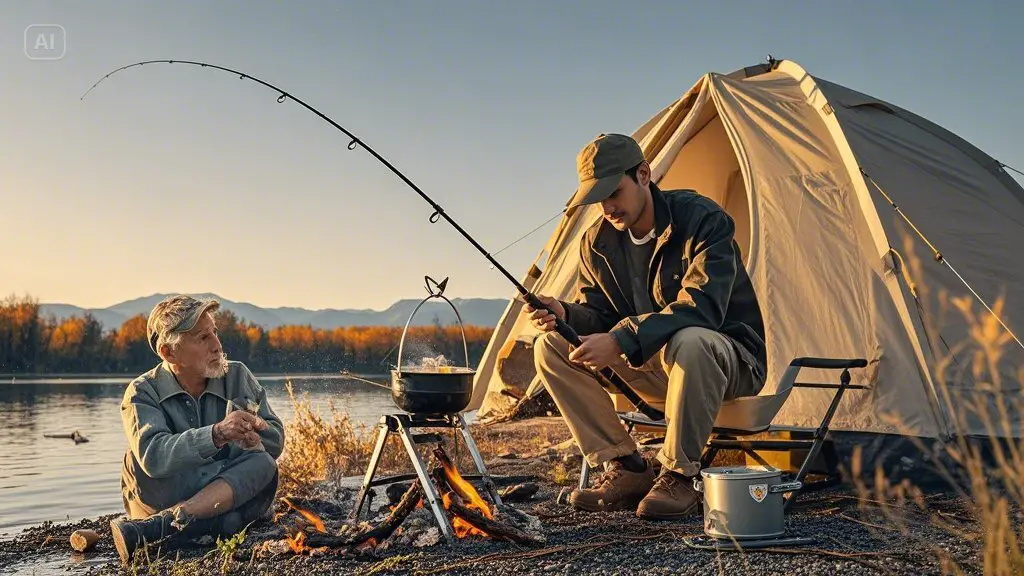How to Catch and Cook Fish, Fishing is more than just a hobby; it’s a fulfilling activity that offers a unique connection to nature and the gratification of creating a meal from your hard work. Whether you’re new to fishing or a seasoned pro, mastering the art of catching and cooking fish adds a fresh layer of enjoyment to your outdoor experiences. Let’s break it down step by step.
Before casting your line, research the best fishing spots and understand the species of fish you’re targeting. Check local regulations to ensure you’re fishing within legal limits and using appropriate methods. Bring the right equipment, including a fishing rod, tackle, and bait, as well as essentials like a cooler, knife, and first aid kit. Proper preparation sets the foundation for success.
Patience is key in fishing. Find a quiet spot, cast your line, and wait. The thrill of a tug on your line is unmatched! Once you’ve caught a fish, handle it with care. If you plan to keep it, ensure you clean and store it immediately to preserve freshness. Scaling and gutting the fish can be done at home or on-site with the right tools.
Cooking your fresh catch is the highlight of the experience. Simple methods often yield the best results. Season the fish with salt, pepper, and a touch of lemon. Grill, bake, or pan-fry it for a flaky, flavorful dish. Pair your meal with fresh sides, like vegetables or rice, to elevate the feast.
Fishing isn’t just about catching fish; it’s about the journey and the joy of savoring nature’s bounty. With practice, you’ll perfect your technique and create memorable meals to enjoy with loved ones.

1. Preparing for Your Fishing Adventure
Before you can cook fish, you need to catch it! Successful fishing starts with proper preparation.
1.1. Research the Best Locations
Every fishing spot is unique, offering different species and challenges. Research local fishing areas—lakes, rivers, or coastal waters—and determine which fish species are available and in season. You can check with local fishing guides, online forums, or community groups for tips.
1.2. Choose the Right Gear
The right fishing gear depends on the species you’re targeting and the fishing method you’ll use. Here’s a basic breakdown:
- Rod and reel: Lightweight spinning rods work well for beginners, while baitcasting rods are better for larger fish.
- Tackle: Bring hooks, sinkers, and lures tailored to your target species. Soft plastics, spinners, and crankbaits are versatile options.
- Fishing Line: Use a monofilament or braided line with a pound test rating suitable for the fish size.
1.3. Pack Essentials
Besides your fishing gear, pack essential items such as a fishing license (if required), a tackle box, a cooler with ice, a sharp fillet knife, and safety equipment like a life jacket.
1.4. Understand the Regulations
Adhering to local fishing regulations is crucial. Learn about size and bag limits, fishing seasons, and protected species. Catching undersized or out-of-season fish can lead to fines and harm ecosystems.

2. Catching Fish: Techniques and Tips
Once you’re prepared, it’s time to hit the water and reel in some fish.
2.1. Selecting the Right Bait
Your bait choice depends on the fish species and their feeding habits.
- Live Bait: Worms, minnows, or shrimp are highly effective for most fish.
- Artificial Lures: Use brightly colored lures for murky waters and natural-colored ones for clear water.
2.2. Mastering Basic Techniques
- Casting: Practice your casting technique to place the bait accurately where fish are likely to be.
- Jigging: A technique that involves lifting and dropping the rod tip to mimic the movement of prey.
- Trolling: Moving a lure or baited hook behind a slowly moving boat to cover a larger area.
2.3. Patience and Observation
Fishing requires patience. Observe the water for signs of activity, like ripples, jumping fish, or birds diving for prey. Early mornings and evenings are often the most productive times.
3. Handling Your Catch
Catching a fish is just the beginning; proper handling ensures the fish remains fresh and ready for cooking.
3.1. Landing the Fish
Use a landing net to scoop the fish out of the water once it’s near the boat or shore. Be gentle to avoid damaging the fish, especially if you plan to release it.
3.2. Humanely Dispatching the Fish
If you plan to keep your catch, it’s important to dispatch the fish quickly and humanely. A swift blow to the head with a blunt object is a common method.
3.3. Cleaning and Storing the Fish
- Gut the Fish: Use a sharp knife to make an incision along the belly and remove the entrails.
- Scale the Fish: Use the back of a knife or a scaler to remove scales if the recipe calls for it.
- Ice It Down: Place the cleaned fish on ice immediately to preserve its freshness.
How to Catch and Cook Fish

4. Cooking Fish: Recipes and Techniques
Now comes the rewarding part—turning your fresh catch into a delicious meal.
4.1. Preparing the Fish for Cooking
- Filleting: Remove the fish’s fillets by slicing along the backbone and ribs.
- Portioning: Cut the fillets into manageable portions for even cooking.
- Marinating: Enhance flavor with marinades of olive oil, garlic, lemon juice, or your favorite spices.
4.2. Popular Cooking Methods
Here are some versatile methods for cooking fish:
- Grilling
Grilling adds a smoky flavor and works well for firm fish like salmon or swordfish.- Preheat the grill to medium-high heat.
- Brush the fish with oil and season with salt, pepper, and herbs.
- Cook for 3-5 minutes per side, depending on the thickness.
- Pan-Frying
A quick and simple method perfect for smaller fish like trout.- Heat a skillet with butter or oil.
- Coat the fish in flour or breadcrumbs for a crispy finish.
- Fry until golden brown, about 2-4 minutes per side.
- Baking
Baking is ideal for whole fish or fillets with delicate textures.- Preheat the oven to 375°F (190°C).
- Place the fish in a baking dish with vegetables, herbs, and a splash of wine or broth.
- Bake for 15-20 minutes, depending on size.
- Poaching
Poaching is a gentle cooking method that preserves the fish’s moisture.- Simmer water or broth with aromatics like onions, garlic, and bay leaves.
- Submerge the fish and cook for 10-15 minutes.
4.3. Popular Fish Recipes
- Fish Tacos: Top grilled or fried fish with shredded cabbage, salsa, and lime crema in a tortilla.
- Fish Chowder: Simmer fish chunks in a creamy broth with potatoes, onions, and celery.
- Lemon Herb Baked Fish: Bake fillets with a drizzle of olive oil, lemon slices, and fresh parsley.

5. Tips for Outdoor Cooking
If you’re cooking outdoors, embrace these tips for a fun and flavorful experience:
5.1. Build a Fire or Use a Camp Stove
A campfire or portable stove is perfect for grilling or pan-frying fish in the wild.
5.2. Use Foil Packets
Wrap the fish with seasonings and vegetables in aluminum foil, then place it on hot coals for easy cleanup.
5.3. Carry Lightweight Cooking Gear
Pack compact cookware like a cast-iron skillet or a portable grill grate for outdoor adventures.
6. Safety and Sustainability
Fishing and cooking are about enjoyment, but it’s important to respect the environment and practice sustainable habits.
6.1. Catch and Release
If a fish is undersized or out of season, handle it gently and release it back into the water. Use barbless hooks to minimize injury.
6.2. Avoid Overfishing
Take only what you need and follow local bag limits to preserve fish populations for future generations.
6.3. Clean Up After Yourself
Leave your fishing spot cleaner than you found it by properly disposing of trash, fishing line, and other waste.

7. Why Catching and Cooking Fish is Rewarding
There’s a special satisfaction in catching your own meal. Fishing teaches patience, connects you to nature, and gives you the chance to savor the freshest seafood imaginable. Plus, it’s an excellent activity to share with friends and family.
With this guide, you’re now ready to catch and cook fish like a pro. So grab your gear, head to the water, and enjoy the journey from reel to table. Whether you’re savoring crispy pan-fried trout by the campfire or serving up gourmet grilled salmon at home, the experience will be one to remember.
Hooked on Tech: Exploring the latest Fishing Gadgets that Anglers swear by.
In the realm of angling, where tradition and technology often converge, a new wave of fishing gadgets has emerged, transforming the way anglers approach their craft.
From advanced fish finders to smart bait systems, these innovations have not only revolutionized the fishing experience but have also garnered a loyal following among anglers worldwide.

























